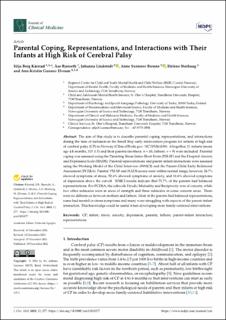| dc.contributor.author | Berg Kårstad, Silja | |
| dc.contributor.author | Bjørseth, Åse Gresseth | |
| dc.contributor.author | Lindstedt, Johanna | |
| dc.contributor.author | Brenne, Anne Synnøve | |
| dc.contributor.author | Steihaug, Helene | |
| dc.contributor.author | Elvrum, Ann-Kristin Gunnes | |
| dc.date.accessioned | 2023-02-09T10:01:53Z | |
| dc.date.available | 2023-02-09T10:01:53Z | |
| dc.date.created | 2023-01-17T17:20:09Z | |
| dc.date.issued | 2022 | |
| dc.identifier.citation | Journal of Clinical Medicine. 2022, 12 (1), . | en_US |
| dc.identifier.issn | 2077-0383 | |
| dc.identifier.uri | https://hdl.handle.net/11250/3049574 | |
| dc.description.abstract | The aim of this study is to describe parental coping, representations, and interactions during the time of inclusion in the Small Step early intervention program for infants at high risk of cerebral palsy (CP) in Norway (ClinicalTrials.gov: NCT03264339). Altogether, 11 infants (mean age 4.8 months, SD: 1.5) and their parents (mothers: n = 10, fathers: n = 9) were included. Parental coping was assessed using the Parenting Stress Index-Short Form (PSI-SF) and the Hospital Anxiety and Depression Scale (HADS). Parental representations and parent–infant interactions were assessed using the Working Model of the Child Interview (WMCI) and the Parent–Child Early Relational Assessment (PCERA). Parents’ PSI-SF and HADS scores were within normal range; however, 26.7% showed symptoms of stress, 52.6% showed symptoms of anxiety, and 31.6% showed symptoms of depression above the cut-off. WMCI results indicate that 73.7% of the parents had balanced representations. For PCERA, the subscale Dyadic Mutuality and Reciprocity was of concern, while two other subscales were in areas of strength and three subscales in some concern areas. There were no differences between mothers and fathers. Most of the parents had balanced representations, some had mental or stress symptoms and many were struggling with aspects of the parent–infant interaction. This knowledge could be useful when developing more family-centered interventions. | en_US |
| dc.language.iso | eng | en_US |
| dc.publisher | MPDI | en_US |
| dc.rights | Navngivelse 4.0 Internasjonal | * |
| dc.rights.uri | http://creativecommons.org/licenses/by/4.0/deed.no | * |
| dc.title | Parental Coping, Representations, and Interactions with Their Infants at High Risk of Cerebral Palsy | en_US |
| dc.title.alternative | Parental Coping, Representations, and Interactions with Their Infants at High Risk of Cerebral Palsy | en_US |
| dc.type | Peer reviewed | en_US |
| dc.type | Journal article | en_US |
| dc.description.version | publishedVersion | en_US |
| dc.source.volume | 12 | en_US |
| dc.source.journal | Journal of Clinical Medicine | en_US |
| dc.source.issue | 1 | en_US |
| dc.identifier.doi | https://doi.org/10.3390/jcm12010277 | |
| dc.identifier.cristin | 2108900 | |
| cristin.ispublished | true | |
| cristin.fulltext | original | |
| cristin.qualitycode | 1 | |

